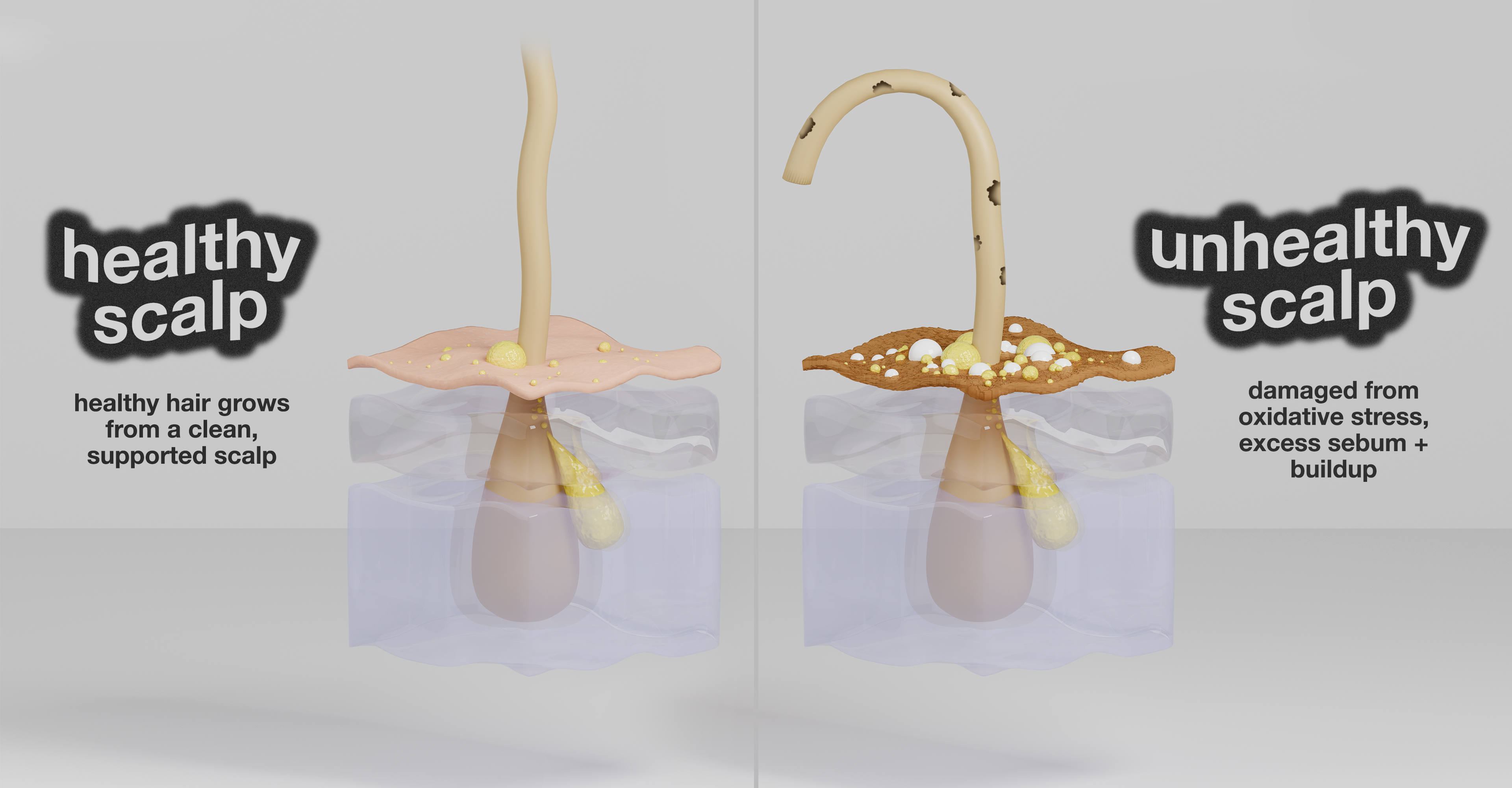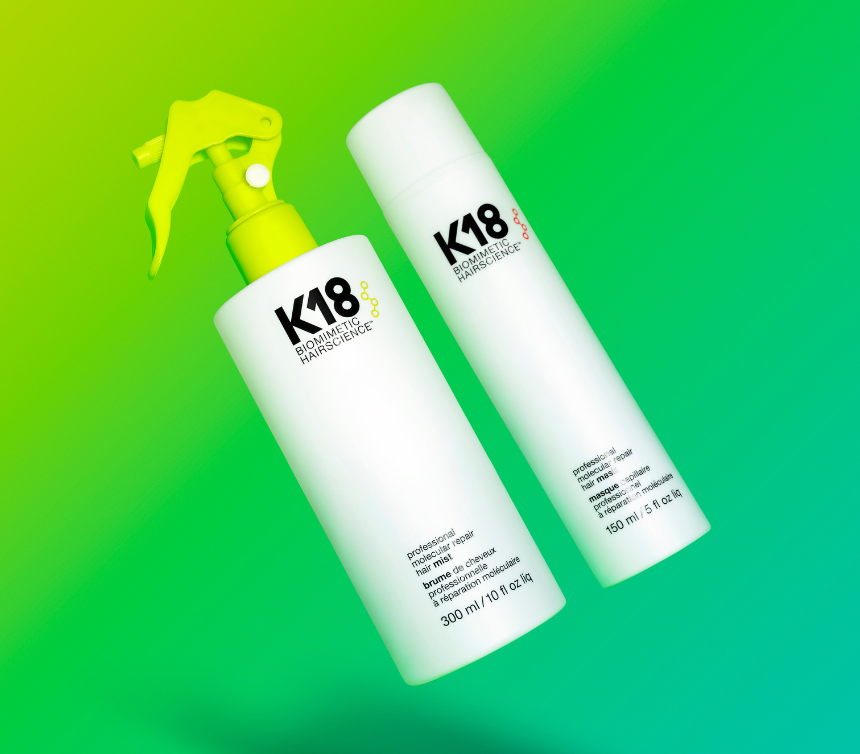As we go through our daily lives, our skin must interact with and fend off environmental aggressors like UV rays, pollution, and chemicals. The same goes for our scalp a.k.a the skin on our heads where hair grows. Many of the scalp’s properties are similar to skin on the rest of our bodies, but the scalp has its own unique characteristics and role to play.
Just like the skin on your face and body, your scalp needs care and attention. Learning what it needs to thrive helps prevent concerns like excess oil, itching, and dandruff and helps hair grow long, thick, and better able to resist damage inside and out.
But what factors contribute to a healthy scalp? Today we’re diving into all things scalp-health: the science behind its relationship to your hair’s health, how damage to the scalp contributes to hair damage, and what you can do for your scalp to ensure healthy hair from root to tip.
Before we begin, here’s a quick list of terms that will be helpful to know as we discuss this important topic:
- sebum: natural oily substance that moisturizes your scalp and hair, but in excess can make them look and feel greasy
- oxidative stress: condition that results from the effects of free radicals and reactive oxygen species and can cause damage if your body cannot counteract
- free radicals and reactive oxygen species (ROS): highly reactive molecules that interact with surrounding lipids and proteins in your scalp and hair which in turn react with other molecules, causing a cycle of damage
the role of your scalp
As we mentioned above, your scalp is the skin on the top of the head and many of its properties are very similar to the rest of your body. However, the scalp has characteristics that are different.
The main difference of your scalp to other skin on your body is the presence of large terminal hair follicles, opposed to the thin or ‘vellus’ follicles found elsewhere. The presence of these hair follicles not only means that scalp skin can be subject to environmental aggressors, but the damage these aggressors cause can also impact the growing hairs within the scalp. Think of your scalp as the earth and your hair as a flower, you need a high-quality and nourishing environment for that flower to thrive. A healthy scalp = healthy hair!
Each strand of hair grows from cells produced in a follicle that’s an integral part of the scalp and these follicles determine the thickness, color and shape of your hair fibers. The health and biology of the scalp can influence the properties of hair, and healthy hair requires a healthy scalp.
Feeding into the hair follicle, beneath the scalp’s surface, is a sebaceous gland, responsible for the production of sebum, natural oils that provide a strong barrier and moisturization to the scalp and hair fibers. Overproduction of sebum can lead to greasy hair or dandruff, and underproduction may lead to the scalp feeling dry or uncomfortable creating flakes and itch.
The hair follicles aren’t the only thing impacting the scalp. Our scalp microbiome works with the skin, helping to protect environmental sources of damage (such as UV rays) manage sebum production, and so much more.
the impact of oxidative stress on scalp and hair health
Oxidative stress is a condition that results from the effects of chemical free radicals and reactive oxygen species (ROS) that can form on the scalp and in the follicle. This can cause damage if the body cannot counteract them.
This stress can be fueled by external aggressors, such as chemical treatment and UV rays, which can disrupt scalp health and impact hair growth. It may also lead to scalp conditions such as premature hair loss or graying, dandruff, and psoriasis.

Here’s how: your hair starts to form in the base of the follicle about four millimeters under your scalp. When a new fiber is growing it takes around two weeks to emerge from your scalp’s surface and during this “pre-emergent” period, your scalp health can have a significant effect on these hairs.
Pre-emergent hair can become damaged by oxidative stress from chemical salon services, UV exposure and pollution and their disruption to the microbiome. The highly reactive molecules that create oxidative stress affect the surrounding lipids and proteins in your scalp and follicle, which then react with other molecules, causing a cycle of damage. If hair emerges from the scalp with damage, it will be more readily prone to further damage as it grows.
Damage from oxidative stress can be seen in the hair in the quality of the cuticle which impacts the look and the how the hair fibers feel. As for the scalp, oxidative stress can lead to inflammation and the upregulation of enzymes that break down collagen within the skin - imagine this as a break down on the scaffolding that is helping support the optimal function of your hair follicles.
Even moderate air and water pollution create the conditions for oxidative stress. Air pollutants called particulate matter (PMs), polycyclic aromatic hydrocarbons (PAHs), and metal and minerals from hard water can stick to your scalp and when exposed to UV rays, these pollutants contribute to that cycle of damage on your scalp and in the growing hair fiber
Further, higher levels of Malassezia—a naturally occurring fungus found in the scalp microbiome— are the main cause of dandruff which is also associated with the creation of higher levels of oxidative stress and changes in the health of the scalp and hair.
all about scalp buildup
In a healthy scalp, the skin cells are constantly renewed as older cells shed. When scalp health is compromised, older cells are not lost so efficiently or there can be an overgrowth of cells. When these cells build up at the scalp’s surface, it can result in the flaking, itchiness, and irritation seen in conditions such as psoriasis and eczema.
The sebum produced by your scalp is important to help protect your skin and retain moisture, but when too much sebum is present on the scalp, it too can build up, making your scalp and hair look and feel greasy.
But that’s not all—an excessive amount of sebum can also alter the activity of the scalp microbiome. The microbes break down the sebum into free fatty acids, these are then oxidised, leading to…you guessed it...oxidative stress.
The amount of sebum the scalp produces varies from person to person, some people naturally produce more than others. When sebum accumulates on hair, it can act as a sticky trap for more pollutants (like the PMs and PAHs we previously mentioned) creating even more oxidative stress to your scalp and hair. Furthermore, excess sebum disrupts your scalp’s pH, weakening your skin barrier and making it more susceptible to damage from environmental irritants.
That means excess buildup can impede hair’s ability to grow long and strong.

The buildup of dead skin cells, sweat, sebum, and haircare products can also cause a flaky scalp and hair follicle inflammation if left unaddressed. Shampoos, conditioners, styling products and conventional dry shampoos can contain waxy ingredients, heavy polymers or particles and their buildup can impact the look and feel of the hair and scalp and our perception of our scalp’s health.
Similarly, if you’re active or produce more sweat than others, sweat can build up on your scalp. This doesn’t only make your scalp look and feel greasy but can also contribute to unpleasant odors and loss of freshness.
our top tips for a healthy scalp
So what can you do to keep your scalp in optimal condition and help defend against the factors that cause oxidative stress and buildup?
Here are a few of our favorites:
● Wash your hair regularly to keep your scalp clean and free of pollutants, excess sebum contaminants and lingering buildup. If you’re not sure how often, read our guide here.
● Use a clarifying shampoo like PEPTIDE PREP™ detox shampoo once a week to remove that excess sebum, those metals and minerals, and product buildup. This has ingredients including Salicylic acid that helps lightly exfoliate to further rid the skin of irritating buildup.
● On non-clarifying wash days, protect your hair and scalp from 3 types of daily damage—the kinds that lead to oxidative stress — with our gentle pH-optimized DAMAGE SHIELD shampoo + conditioner.
● Between washes, maintain the scalp sebum balance, reduce excess oil, and eliminate odors with AirWash™ dry shampoo. AirWash™ keeps working for up to 3 days*, providing long-lasting hair fiber protection and scalp support thanks to OdorBINDTM and scalp-friendly ingredients like biotech-derived Mediterranean microalgae.
● Streamline your routine. Less is more when it comes to healthy hair, so nix harsh and unnecessary ingredients and opt for gentle, effective formulas that won't irritate your scalp or strip it of oils.
Safeguard scalp wellness for strong, healthy hair—no matter your hair type, texture, or lifestyle.



